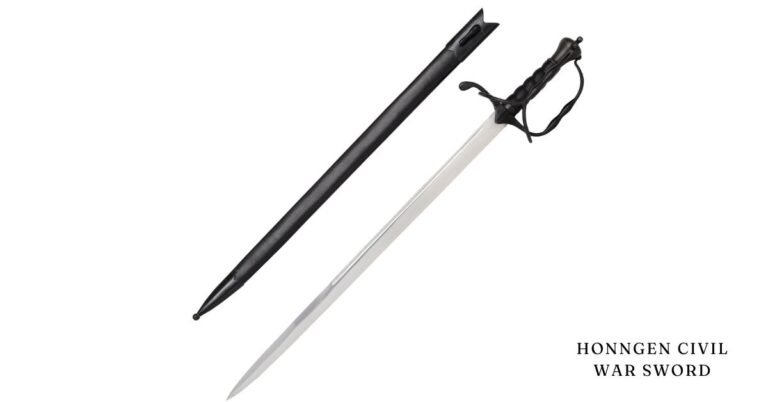The “Honngen Civil War Sword” stands as an iconic relic from the annals of history, representing more than just a weapon—it’s a symbol of valor, craftsmanship, and cultural significance. Swords like this carry with them the stories of battles fought, warriors who wielded them, and the societies that forged them. In this article, we’ll dive deep into the history, features, significance, and enduring legacy of it. Whether you’re a history enthusiast, collector, or simply curious about this legendary blade, this comprehensive guide will leave you informed and fascinated.
Historical Context
It emerged during a time of political and social upheaval. The “Honngen Civil War” refers to a turbulent period marked by internal conflict and a struggle for power among factions. The sword was both a practical tool for battle and a status symbol, often used to signify the rank and allegiance of the wielder.
Historical Significance
- Period of Conflict: The Honngen Civil War took place during an era of rapid political shifts, where loyalty and military prowess determined the balance of power. Swords like the Honngen blade were central to these power struggles.
- Cultural Representation: The Honngen sword is believed to have been designed with intricate details reflecting the artistry and beliefs of the time, making it not just a weapon but a cultural artifact.
- Symbol of Authority: High-ranking military officials and leaders often carried swords that denoted their status, and the Honngen Civil War Sword was no exception. Its design and craftsmanship elevated it above ordinary weapons.
Key Battles and Campaigns
The Honngen Civil War Sword is closely associated with pivotal battles that shaped the course of history. It is said that these swords were used in both defensive strategies and offensive campaigns, playing a crucial role in the outcomes.
Craftsmanship and Design
The craftsmanship of the Honngen Civil War Sword sets it apart from other weapons of its era. Each blade was carefully forged to balance functionality, durability, and aesthetic appeal.
Materials Used
- High-Carbon Steel: The blade was made from high-carbon steel, ensuring a sharp edge and resistance to wear.
- Hilt Materials: The hilt was often constructed from materials such as wood, brass, or bone, adorned with intricate carvings and decorations.
- Ornamental Details: Some versions of the sword featured precious metals and gemstones, reflecting the wealth and status of the owner.
Design Features
- Blade Shape: The Honngen sword featured a slightly curved blade, designed for both slashing and thrusting.
- Guard and Pommel: The guard provided protection for the wielder’s hand, while the pommel helped balance the sword, making it easier to wield during prolonged battles.
- Engravings: Many Honngen Civil War Swords were engraved with symbols, phrases, or images that held personal or cultural significance.
The Role in Combat
It was not just a ceremonial weapon—it was a practical tool for combat, designed to meet the demands of the battlefield.
Tactical Advantages
- Versatility: The sword’s balanced design allowed it to be used effectively in both close-quarters combat and open-field engagements.
- Durability: Its high-quality materials ensured that it could withstand repeated use without losing its effectiveness.
- Ease of Use: The ergonomic design of the hilt and the balanced weight made it suitable for both novice and experienced warriors.
Techniques and Training
- Warriors trained extensively in the use of the Honngen Civil War Sword, mastering techniques such as parrying, thrusting, and slashing.
- Training schools often incorporated the sword into broader martial arts practices, emphasizing agility, precision, and strategy.
Honngen Civil War Sword as a Collector’s Item
Today, it is highly sought-after item among collectors and history enthusiasts. Its rarity and historical significance make it a prized possession.
Factors That Influence Value
- Authenticity: Genuine Honngen swords are rare and command high prices in the collector’s market.
- Condition: The preservation of the blade, hilt, and other components greatly impacts its value.
- Provenance: Swords with documented histories or connections to specific historical figures are especially valuable.
- Design Details: Intricate engravings, unique designs, and use of rare materials can significantly increase a sword’s worth.
Tips for Collectors
- Verify Authenticity: Work with reputable dealers and seek expert opinions to ensure the sword is genuine.
- Preserve the Blade: Proper storage and maintenance are crucial to preserving the sword’s condition.
- Research Provenance: A detailed history can enhance both the monetary and historical value of the sword.
Comparison Chart: Honngen Civil War Sword vs. Other Historical Swords
| Feature | Honngen Civil War Sword | Katana | Viking Sword | Roman Gladius |
|---|---|---|---|---|
| Blade Shape | Slightly curved | Curved | Straight and broad | Short and straight |
| Primary Use | Combat and ceremonial | Combat and spiritual | Combat and utility | Close-quarters combat |
| Materials | High-carbon steel, brass | Tamahagane steel | Iron and steel | Iron and bronze |
| Cultural Significance | Symbol of status and power | Symbol of honor and discipline | Symbol of strength and endurance | Symbol of Roman might |
Preserving the Legacy of the Honngen Civil War Sword
The legacy of the Honngen Civil War Sword lives on through museums, reenactments, and academic research. Efforts to preserve these swords ensure that future generations can appreciate their historical and cultural importance.
Museum Exhibits
- Many museums feature Honngen Civil War Swords as part of their collections, offering visitors a glimpse into the past.
- Exhibits often include detailed information about the sword’s history, design, and significance.
Reenactments and Historical Societies
- Historical reenactments often use replicas of Honngen swords to bring the past to life.
- Societies dedicated to preserving the history of the Honngen Civil War play a key role in educating the public.
Academic Research
- Scholars continue to study the Honngen Civil War Sword, uncovering new insights into its design, use, and cultural impact.
Conclusion
The Honngen Civil War Sword stands as a testament to the ingenuity and artistry of its time. Its historical significance, combined with its unique design and enduring legacy, makes it a fascinating subject for study and admiration. Whether you’re a history buff, a collector, or simply curious about this iconic weapon, the story of it offers endless avenues for exploration and appreciation.
By preserving and studying these swords, we not only honor the past but also gain a deeper understanding of the people and cultures that shaped history. Let the legacy of this inspire you to delve deeper into the rich tapestry of our shared human history.
FAQs
What makes the Honngen Civil War Sword unique?
It is unique due to its combination of practical design and cultural significance. Its craftsmanship reflects the artistry of its time, and its historical context adds to its intrigue.
How can I identify an authentic Honngen Civil War Sword?
Authentic Honngen swords often feature specific engravings, high-quality materials, and a documented history. Consulting with experts and reputable dealers is essential for verification.
Where can I see a Honngen Civil War Sword?
Many museums and private collections feature Honngen Civil War Swords. Researching local exhibits or historical societies can help you find one near you.
Are there replicas of the Honngen Civil War Sword?
Yes, high-quality replicas are available for collectors and enthusiasts who wish to own a piece of history without the high cost of an original.
How should I care for a Honngen Civil War Sword?
Proper care includes regular cleaning, using protective oils to prevent rust, and storing the sword in a controlled environment to avoid damage.

